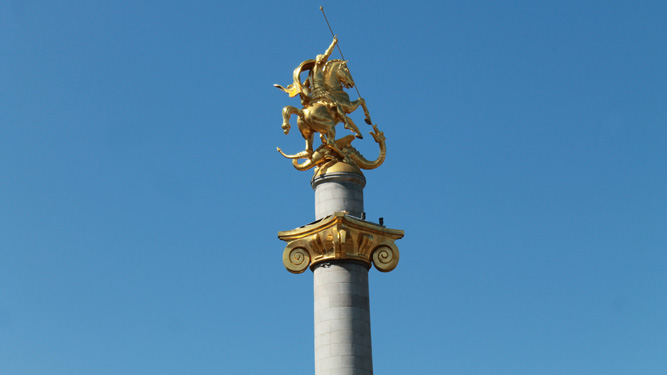
EUROPEAN ARCHITECTS IN TBILISI
EUROPEAN ARCHITECTS IN TBILISI
This route includes the residential and public edifices designed by foreign architects in Tbilisi, which have contributed to creation of the artistic and historical image of the city.
1| 2, FREEDOM SQUARE.
TBILISI SAKREBULO – TBILISI CITY COUNCIL.
The building was built under the Imperial Russian rule in the 1830s and reconstructed several times. It served, until 1879, as a Chancellery of Chief Policemaster and police department. A competition announced in 1878 for the remodeling the building to the City Hall (Gorodskoy Dom) was won by the architect Paul Stern’s project. The facade reflects the then-popular Exotic style with Neo-Moorish design. A tower was added in 1910 and the building was further expanded in 1912.
2| 22, GALAKTION TABIDZE STREET.
The residential house belongs to the family of Tamamshevs and was built by architect Aleksander Salzmann in 1883. Its architectural decor is finished in old Georgian style.
3| 13, MACHABELI STREET.
The two-storey modernistic residential house with a mezzanine was built in 1905 based on the design of German architect Karl Zaar. The house belonged to outstanding Georgian businessman and patron of art Davit Sarajishvili (1848-1911). Since 1921 the building has functioned as the headquarters of the Georgian Writers’ Union. The house has a beautiful door rich in ornaments, and a hall lined with colorful marble. Arched plafonds are decorated with floral images and arches stand out for their colorful caissons.
4| 6, G. KIKODZE ST.
RESIDENTIAL HOUSE.
Two-storey residential house built in 1906 with the design of famous architect from Tbilisi Aleksander Ozerov (1849-1922).
5| 6, PAVLE INGOROKVA STREET.
Two-storey residential house built in two stages. Its main part was built on 3 September 1887 with the design of architect Aleksander Shimkevich.
6| 20, PAVLE INGOROKVA STREET.
Two-storey modernistic residential house built in 1914. Its interior was of particular importance. The design belongs to architect from Tbilisi Mikheil Neprintsev (1877-1962).
7| 6, RUSTAVELI AVENUE, YOUTH PALACE.
Initially Palace of the Vice Regent of the Russian Empire and later the Government House of the Democratic Republic of Georgia was built in 1845-1847 with the design of Semionov. Later, in 1858-1859 Architect Otto Jacob Simonson gave the palace an innovative touch: a classicist facade with elements of the renaissance was replaced by a harmonious assembly of angular and rugged rustic work, alteration of Corinthian pilasters and arches, arcade of galleries, medallions and circular pediments. The palace is noted for its beautiful garden and a mirror-lined large hall.
NATIONAL LIBRARY
8| 3-5, GUDIASHVILI ST.
Former Nobles’ Bank. The main building was built in 1913-1916 with the design of architect Anatoli Kaligin and artist Heinrich Hrinevsky. The architecture is noteworthy for its application of Georgian traditional forms. The interior stands out for its rich paintings and decorations.
9| ALEXANDER’S GARDEN.
Designed by Otto Jacob Simonson and developed with contribution of gardener Heinrich Karel Werner Scharar in 1859, it was the first public garden in Tbilisi.
10| RUSTAVELI AVENUE, THE KASHVETI CHURCH OF ST. GEORGE
is a Georgian Orthodox church in central Tbilisi, across the Parliament building in Rustaveli Avenue. The oldest church was built here in the 6th c. but it was further replaced first in the 18th c. and then at the dawn of the 20th c. with the design of architect Leopold Billfeld. His design took after one of the masterpieces of Georgian architecture – Samtavisi Cathedral of the 11th c. Kashveti church is one of the best examples of how new architecture can apply old traditional forms in design. By the end of the 19th c. the yard came to host a small Baratashvili family vault. The church stands out for its beautiful decoration of the altar painted by the prominent Georgian artist Lado Gudiashvili in 1947.
11| RUSTAVELI AVENUE, NATIONAL PICTURE GALLERY.
designed by architect Albert Salzmann The former ‘Cathedral of Glory’ or a military and history museum was built in 1888-92 as a prototype of the Exhibition Palace in Rome and has served as a picture gallery since the 1930s. Working hours: every day except Monday, 11.00 – 18.00
12| 31, ATONELI ST.
RESIDENTIAL HOUSE
Former hotel London was designed by Architect Otto Jakob Simonson and owned by Aleksandre Zubalashvili. The hotel was opened in 1875 and functioned as one of the luxurious spots in the city through the 1900s. Its visitors at various times included an English scholar and translator of the Knight in the Panther’s Skin Marjory Wardrop and Norwegian author Knut Hamsun. The hotel had a casino frequented by famous Georgian writer and public figure Ilia Chavchavadze. On 28 June 1890 the hotel hosted the first public hearing session of the phonograph invented by Thomas Alva Edison.
13| 17, RUSTAVELI AVENUE
SHOTA RUSTAVELI STATE ACADEMIC THEATRE.
Designed by architects Aleksander Shimkevich and Korneli Tatischev. Famous artists Davit Kakabadze, Lado Gudiashvili, Ilia Zdanevich and Serge Sudeikin contributed by painting the walls of the basement Cafe Chimerion opened in 1919 and being a gathering place for the city’s bohemian world of poets and artists.
14| 25, RUSTAVELI AVENUE
ZAKARIA PALIASHVILI STATE ACADEMIC THEATRE OF OPERA AND BALLET
Designed and built by Viktor Schreter, an architect from Petersburg in 1880. The building is greatly characterized by elements of Islamic architecture, with an accentuated and richly ornamented portico. The interior is also decorated in pseudo-Moresque style.
This house referred to as Melik Azariants house was built by architect Nikolai Obolensky in the dawn of the 20th c. and is one of the outstanding pieces of then popular modernistic style. Its facade is richly decorated by figured carvings, garlands,
crowns, etc.
16| 8, AL. GRIBOEDOV`S STR.
CONSERVATOIRE.
Former musical school. Architect – Aleksander Shimkevich.
17| 32, ZUBALASHVILIS STR.,
SUPREME COURT.
Built by the end of the 19th c with the design of architect Aleksander Shimkevich.
18| CHURCH OF MIKHEIL OF TVERI.
At the foothills of Mtatsminda Mt. Architect I. Dizmann.
1| 16, MARJANISHVILI STREET.
CENTRAL BRANCH OF TBC BANK.
Built in 1913 based on the design of architect Aleksander Rogosky the building initially served as the quarters of the Caucasian Officers’ Economic Society. The building has an impressive dome and is a good example of modernistic architecture.
2| 8, MARJANISHVILI STREET.
MARJANISHVILI THEATRE.
This former Public House was built at the initiative of Georgian businessman K. Zubalashvili with the design of S. Krichinsky, an architect from St. Petersburg. Notwithstanding the multiple reconstructions the building has retained many originally modernistic elements, including the facade.
3| CHURCH OF ST. PETER AND ST PAUL IN JAVAKHISHVILI STREET.
The church was built in 1870-1877 with financial sponsorship of businessman Konstantine Zubalashvili and architectural design of Albert Salzmann. Its parish mainly consisted of the Poles exiled in Georgia after the Polish insurrection. It is also noteworthy as the church where Pope John Paul II held his mass during his visit in Tbilisi in 1999. The architecture follows the trend prevailing in Roman churches of early baroque style, namely that of Il Gesu Church in Vignola.
4| 17,TERENTI GRANELI STREET.
LUTHERAN CHURCH.
German Lutheran Church was built in 1996-1997 at the initiative of Pastor Gerdt Hummel. 19th c. was marked with a concentration of German Diaspora in the area of present Aghmashenebeli Avenue. They initially built a small church in Marjanishvili Square. In 1894-1897 architect L. Bilfeld constructed a large neo-gothic Lutheran church, a so-called Kirche in its place, which was destroyed in 1945.
5| 101/2 AGHMASHENEBELI AVENUE
TBILISI STATE PUPPET THEATRE.
Former Wetzel Hotel was built in the second half of the 19th c. with the design of architect L. Bilfeld and belonged to merchant Friedrich Wetzel. The architecture mainly follows German baroque style.
6| 10, KRYLOV STREET.
RESIDENTIAL HOUSE. ARCHITECT – I. DIZMANN.
7| 135, AGHMASHENEBELI AVENUE.
FORMER APOLO CINEMA.
The building was one of the oldest in Tbilisi that quartered a cinema in the city. Opened in 1909, the building is a good example of modernistic style, with its rich decorations of the facade and interior. The architect remaining unknown, the sculptors were A. Nowak and Karl Souchek.
8| 6, KARGARETELI STREET.
MUSEUM OF CINEMA, THEATRE AND MUSIC
Museum was built in 1895 with the design of architect P. Stern. Its architecture encompasses gothic and classicistic elements. The museum exhibits amazing materials reflecting the history of old and modern Georgian Theatre, cinema, music and choreography, including an antique theatrical mask discovered in the excavations in Vani and pieces of avant-garde art of the 20th c. Working hours: everyday except Monday, 10.00 – 17.00
9| 150, AGHMASHENEBELI AVENUE.
MAGNETIC METEOROLOGICAL OBSERVATORY
Observatory was built at the initiative of German astronomer A. Moritz. The main building was designed by architect Otto Simonson in 1858 and is an exemplary piece of classicistic style. In 1970 the observatory was transformed into the museum of geophysical sciences.
10| STATE SILK MUSEUM.
Former Main Building of Caucasian Silk Station was designed by Al. Shimkevich in 1892. It is one of the oldest museums in Tbilisi and stands out for its collection of world history of silk industry that is one of the oldest in the world, including 5000 species and variations.
©GEORGIAN NATIONAL TOURISM ADMINISTRATION

